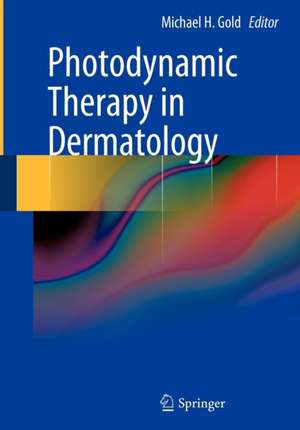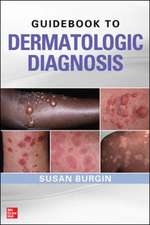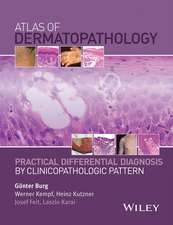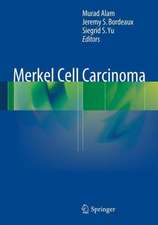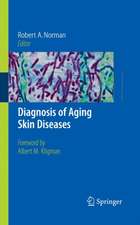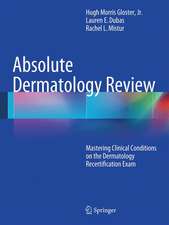Photodynamic Therapy in Dermatology
Editat de Michael H. Golden Limba Engleză Hardback – 3 mai 2011
| Toate formatele și edițiile | Preț | Express |
|---|---|---|
| Paperback (1) | 840.44 lei 43-57 zile | |
| Springer – 23 aug 2016 | 840.44 lei 43-57 zile | |
| Hardback (1) | 725.42 lei 43-57 zile | |
| Springer – 3 mai 2011 | 725.42 lei 43-57 zile |
Preț: 725.42 lei
Preț vechi: 763.60 lei
-5% Nou
138.81€ • 145.32$ • 114.86£
Carte tipărită la comandă
Livrare economică 07-21 aprilie
Specificații
ISBN-10: 1441912975
Pagini: 216
Ilustrații: X, 205 p.
Greutate: 0.66 kg
Ediția:2011
Editura: Springer
Colecția Springer
Locul publicării:New York, NY, United States
Public țintă
Professional/practitionerCuprins
1. History of Photodynamic Therapy - 2. Aminolevulinic Acid: Actinic Keratosis and Photorejuvenation - 3. 5-Aminolevulinic Acid: Acne Vulgaris - 4. Photodynamic Therapy for the Treatment of Sebaceous Gland Hyperplasia - 5. Photodynamic Therapy for Hidradenitis Suppurativa - 6. Topical Methyl Aminolevulinate-Photodynamic Therapy for the Treatment of Actinic Keratosis - 7. Methyl Aminolevulinate in Skin Cancers - 8. Methyl Aminolevulinate: Photorejuvenation - 9. Photodynamic Therapy of Acne - 10. Photodynamic Therapy for the Treatment of Verrucae, Condylomata Acuminata, and Molluscum - 11. Photodynamic Therapy and Inflammatory Disorders - 12. Photodynamic Therapy for Other Uses - 13. Chemoprevention of Skin Cancer with Photodynamic Therapy - 14. Fluorescence-Guided Photodynamic Therapy - 15. How I Perform ALA-Photodynamic Therapy in My Practice - 16. How We Perform Photodynamic Therapy MAL in Clinical Practice - 17. The Future of Photodynamic Therapy
Recenzii
“This book reviews the use of photodynamic therapy (PDT) in dermatology, covering both established uses and its use for conditions that are not commonly treated with this method. … The book is appropriate for dermatologists in training or practice, and it would be a good resource for dermatologists planning to incorporate PDT into their practice. … With its updates and in-depth practical tips on the use of PDT that other books do not have … this is a useful book.” (Roger C. Lee, Doody’s Review Service, September, 2011)
Notă biografică
Michael H. Gold, MD, is a Clinical Assistant Professor of Dermatology at both Vanderbilt University School of Medicine and Vanderbilt University School of Nursing. He is also a dermatologic and cosmetic surgeon at the Gold Skin Care Center in Tennessee, as well as its founder and medical director.
Textul de pe ultima copertă
Photodynamic Therapy in Dermatology is the first book to cover global research on photodynamic therapy (PDT) in the management of skin disease. Although a relatively young procedure, PDT has enjoyed increased popularity during the last ten years. As research has grown, two distinct routes have appeared: the United States model and the European one, each focusing on different uses and photosensitizers. Dr. Gold has assembled the world’s experts on PDT to create a book that concisely covers every use and photosensitizer available around the world and includes comprehensive coverage of both of the FDA-approved photosensitizers in the United States, all the while carefully differentiating between off-label and FDA-approved uses of photodynamic therapy.Photodynamic Therapy in Dermatology emphasizes how to integrate PDT into practice. Toward this end, it is organized by disease category, with each chapter providing a systematic discussion of indications, PDT approaches from country to country, common side effects, prognosis as well as the underlying science. The book will be of value to dermatologists seeking a state-of-the-art review of PDT around the world, the latest in its clinical uses, and guidance on how to incorporate PDT into clinical practice.
Caracteristici
Organized by disease category Newest FDA approved photosensitizer included
Contributions from leading US and European researchers on PDT
Details on how to incorporate PDT into daily clinical practice
Descriere
Photodynamic therapy is a proven effective treatment of actinically damaged skin cells, nonmelanoma skin cancers, and acne and other pilosebaceous conditions. As an agent for general facial rejuvenatin it has untapped potential. The current state of PDT therapy and future applications are discussed in detail in this exciting new volume. Throughout, the focus is on evidence-based clinical uses of PDT, including pretreatment regimens, avoidance and management of complications, and posttreatment suggestions.
